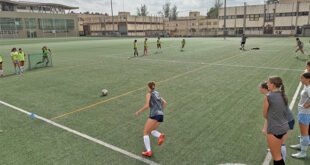“It’s the highest collegiate turf surface in the nation”
by Than Acuff
While there remains a “punch list” of things to do, the brand new turf field at Western Colorado University (WCU) is pretty much completed.
Nationwide, collegiate sports programs, especially at the Division I level, generate millions of dollars in funds for universities and ultimately education. WCU and alumnus Paul J. Rady have flipped that equation on its head, turning out a generous donation for a new academic building and programming that will benefit athletic programs as well.
In the fall of 2018 Rady donated $80 million to the college, one of the largest gifts to a public university in the state of Colorado. The donation enabled the establishment of a new Paul M. Rady School of Computer Science and Engineering through collaboration with the University of Colorado–Boulder College of Engineering and Applied Science. After further discussion, the site was picked—right where Gateway Field was, the home of the WCU Mountaineers women’s soccer team.
Head coach Amy Bell first heard of the move in the summer of 2018 and then the plan of where to put a new turf field that fall. She looked forward to getting artificial turf to play and train on. “Our old field was real grass, which there aren’t many non-artificial turf surfaces left in the RMAC [Rocky Mountain Athletic Conference],” says Bell. “It did present a challenge, to play away games on turf after practicing on real grass all week.”
With the need to replace that field and a desire to build a turf multi-use facility, Rady agreed to cover the cost of that project as well.
“We’ve always wanted a turf field here,” says WCU director of athletics Miles Van Hee. “It’s the highest collegiate turf surface in the nation.”
It wasn’t all smooth going, though. The scheduled opening for the field was August 18, in time for the start of the women’s college soccer season, but the project had its fair share of unforeseen delays.
“It was a bigger undertaking than we anticipated,” says Van Hee. “There were a lot of complications and getting it ‘tied in’ made it more complicated.”
The setbacks left the Mountaineers without a field during their entire season this past fall, forcing them to play their home games at Colorado Mesa University in Grand Junction.
“The team did a wonderful job with morale. They stayed focused and optimistic but it did make them pretty exhausted being on the road each weekend,” says Bell. “We could really see the fatigue setting in after a while.”
The complications led to using up all of the funds that included money for lights. Fortunately, Rady came through again, agreeing to cover the additional cost to get lights for the field, bringing the total cost to somewhere in the neighborhood of $2.5 million.
“You want to do it right and get a first-class facility,” says Van Hee.
Now the lights are up, the turf is down and while the field was not officially open, the women’s team was the first to enjoy it, with a team scrimmage under the lights last week.
“The brand new field is absolutely gorgeous,” says Bell. “I believe at some point it will be voted as one of the most beautiful Division II soccer venues.”
Furthermore, Bell sees it as an opportunity for the program to improve and improve its efforts getting student athletes to come to WCU.
“It will help us be even more competitive in the RMAC,” explains Bell. “The field really helps our recruiting. It is a brand new and very well done field. When prospective student athletes see it and the view it holds, they can’t help but fall in love with it.”
And while the women’s soccer team was the priority in building the new facility, Van Hee explains that it will benefit innumerable athletic programs now and in the future, for the university as well as the community. They are currently working on a fee structure to have in place when entities outside of the university wish to use it.
“It’s for all of our programs,” says Van Hee, “and not only for campus but the community as well when it’s available.”
Van Hee did point out that they are focused on keeping their new facility in quality shape and will remain cognizant of the potential for overuse. Turf fields can last anywhere from 10 to 20 years but they take a beating at higher altitude and with over-use. He pointed out the turf at Colorado Mesa University is already showing signs of wear after three years.
“We want it to last,” says Van Hee. “We will be protective of it.”
The university is planning to hold an official opening of the facility in the spring of 2020.
 The Crested Butte News Serving the Gunnison Valley since 1999
The Crested Butte News Serving the Gunnison Valley since 1999



